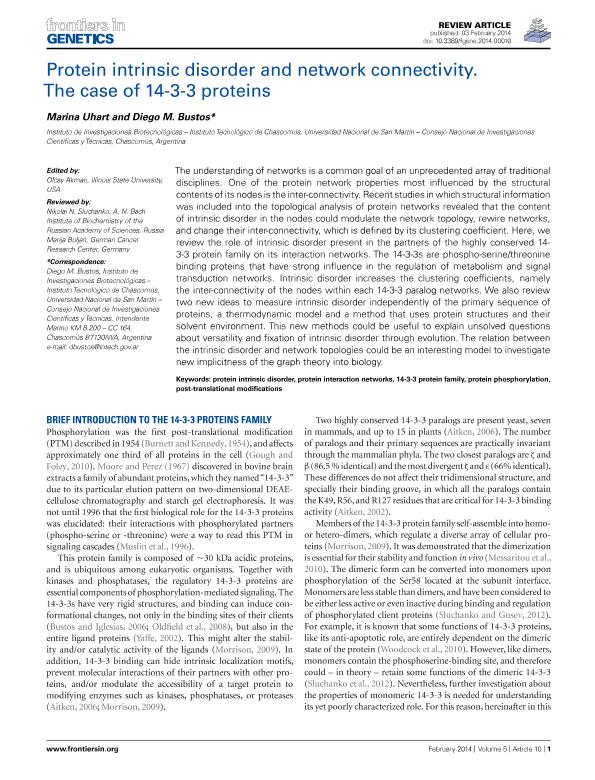Artículo
Protein intrinsic disorder and network connectivity. The case of 14-3-3 proteins
Fecha de publicación:
02/2014
Editorial:
Frontiers
Revista:
Frontiers in genetics
ISSN:
1664-8021
Idioma:
Inglés
Tipo de recurso:
Artículo publicado
Clasificación temática:
Resumen
The understanding of networks is a common goal of an unprecedented array of traditional disciplines. One of the protein network properties most influenced by the structural contents of its nodes is the inter-connectivity. Recent studies in which structural information was included into the topological analysis of protein networks revealed that the content of intrinsic disorder in the nodes could modulate the network topology, rewire networks, and change their inter-connectivity, which is defined by its clustering coefficient. Here, we review the role of intrinsic disorder present in the partners of the highly conserved 14-3-3 protein family on its interaction networks. The 14-3-3s are phospho-serine/threonine binding proteins that have strong influence in the regulation of metabolism and signal transduction networks. Intrinsic disorder increases the clustering coefficients, namely the inter-connectivity of the nodes within each 14-3-3 paralog networks. We also review two new ideas to measure intrinsic disorder independently of the primary sequence of proteins, a thermodynamic model and a method that uses protein structures and their solvent environment. This new methods could be useful to explain unsolved questions about versatility and fixation of intrinsic disorder through evolution. The relation between the intrinsic disorder and network topologies could be an interesting model to investigate new implicitness of the graph theory into biology.
Archivos asociados
Licencia
Identificadores
Colecciones
Articulos(CCT - LA PLATA)
Articulos de CTRO.CIENTIFICO TECNOL.CONICET - LA PLATA
Articulos de CTRO.CIENTIFICO TECNOL.CONICET - LA PLATA
Articulos(IIB-INTECH)
Articulos de INST.DE INVEST.BIOTECNOLOGICAS - INSTITUTO TECNOLOGICO CHASCOMUS
Articulos de INST.DE INVEST.BIOTECNOLOGICAS - INSTITUTO TECNOLOGICO CHASCOMUS
Citación
Bustos, Diego Martin; Uhart, Marina; Protein intrinsic disorder and network connectivity. The case of 14-3-3 proteins; Frontiers; Frontiers in genetics; 5; 10; 2-2014; 1-7
Compartir
Altmétricas
Items relacionados
Mostrando titulos relacionados por título, autor y tema.
-
Mayol, Gonzalo Federico ; Defelipe, Lucas Alfredo ; Arcon, Juan Pablo ; Turjanski, Adrian ; Marti, Marcelo Adrian (American Chemical Society, 2022-08)
-
Uhart, Marina ; Flores, Gabriel; Bustos, Diego Martin (Nature Publishing Group, 2016-05)
-
Fernández, Julián Francisco; Lavecchia, Martín José (Taylor & Francis, 2020-12-28)




